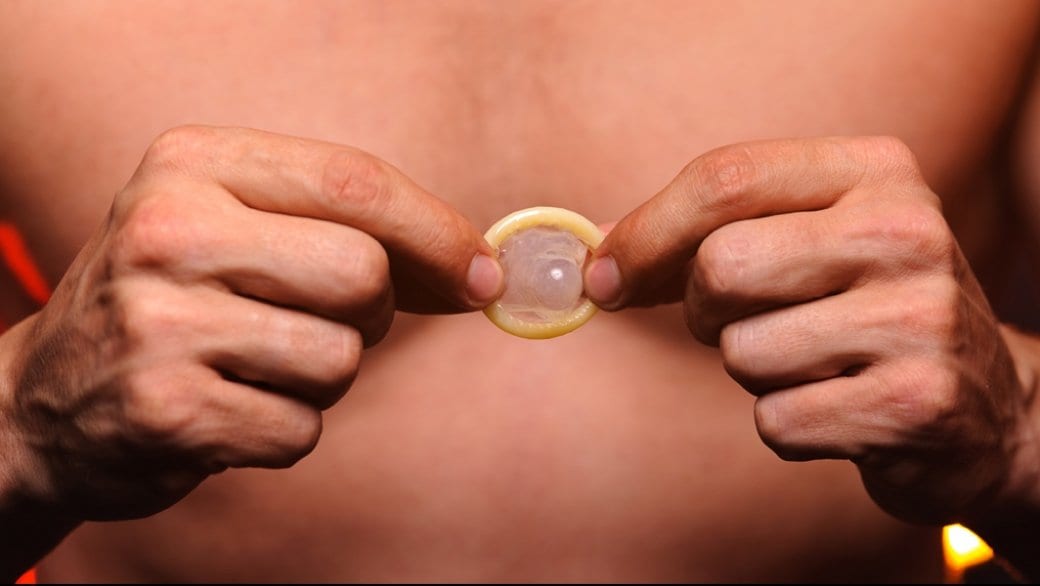After fucking this guy, Don, who I’d been dating for a few weeks, we noticed that the condom had broken. Up until that point the sex was great, but needless to say the incident ruined the good vibes. Instead of cuddling afterwards, Don wanted to know how safe I was with my own sexual health. I told him that I always wore condoms for anal sex but not for oral. Mind you, the risk of contracting HIV by blowing another dude is only zero to one in 2,500, or zero to 0.04 percent.
Don said that he always wore a condom too, so I felt much more at ease. Still, he became kind of distant in the following days.
I hate how a scare like this can ruin perfectly good sex. It also bugs me that I’ve become more paranoid as a result, making it difficult to relax during sex.
We are told that when used correctly, condoms are 98 to 99 percent effective, but that’s in a lab setting. What about in the real world? And what about men who have sex with men (MSM), a group that continues to be disproportionately affected by HIV/AIDS?
A 2013 Centers for Disease Control and Prevention (CDC) report found that for men who have sex with men and use condoms every time, they’re 70 percent less likely to acquire HIV than guys who never use condoms at all.
In the instance with Don, none of those things applied but the condom still broke.
In 2014, a Canadian study looked at 92,963 HIV-negative MSM who had anal sex with and without a condom. Of the 693 new HIV infections, 51 percent of them were wearing a condom during anal sex.
A 2016 study on condom breakage during anal sex among MSM claimed that the estimated failure rate of condoms was between 0.5 percent to eight percent, and this failure might be more common for younger men, men who drink or take drugs before sex, and men with a higher number of sex partners.
With all these studies we begin to see that it’s not exactly evident the extent to which condoms prevent new HIV transmissions.
How does all of this stack up to the level of protection that pre-exposure prophylaxis (PrEP) offers when comparing it to condom use? Despite three known PrEP failures, using Truvada for PrEP is 92 to 99 percent effective in reducing HIV transmission risk for HIV-negative people. It’s recommended you take it every day to get the maximum protection; for every dose missed, your protection decreases.
That’s what I’d loved about being on PrEP for that short time. For the most part I still wore condoms during sex but if a condom slipped off or broke, who cares? It was the first time in my life that I truly experienced carefree sex — and pleasure should also matter.
On the Monday, Don and I went to get rapid HIV tests. We were taken to separate rooms at the clinic. Despite how confident I was that things were going to be okay, I felt the same nervousness that I used to get when I first started getting HIV tests back in my late teens.
In my head, I replayed all the sex I’d had since my last test, having to convince myself that everything was okay even though I knew that it was. It then struck me that I’d had some nights where I’d gone home with someone after the bar but couldn’t remember all the details because I’d been drinking; I don’t remember not using a condom, but I don’t necessarily remember using one either.
The nurse started explaining the whole “reactive” and “negative” part of the rapid test, but I didn’t catch whether one dot was reactive or whether it was two; my mind was still replaying those drunken nights in my head, trying to determine whether I had been safe or not.
“Sorry, one dot is reactive?” I tried to confirm.
“No, one dot is negative. Two is reactive,” he said.
When he poked my finger for blood, it felt like time had stopped. Not only did I have to remind myself to breathe, but to exhale as well.
The nurse left the room. Why do they always leave the room?
He finally came back in, made some silly joke, which I didn’t catch, but I did hear him say “It’s one dot. Negative, non-reactive.”
Large exhale.
I met Don in the waiting room. Fortunately, he too was non-reactive.
We lasted a couple of months after that but the sex was never quite the same.
None of this is to discredit condom use in any way. This is more to discredit those who try to discredit PrEP. We have several tools now to help curb new HIV transmission rates and some are more powerful than others, but they all contribute to eventually making HIV a non-reality. So the next time someone suggests that men should forget about PrEP and wear condoms, you might want to remind them of the effectiveness of PrEP.
PrEP School runs every other Monday on Daily Xtra. Columnist Mike Miksche explores and navigates the world of sex and PrEP.

 Why you can trust Xtra
Why you can trust Xtra


